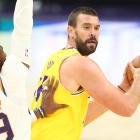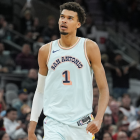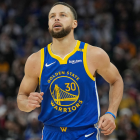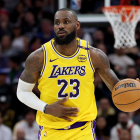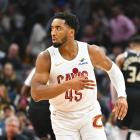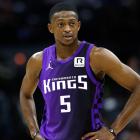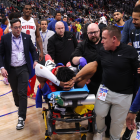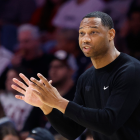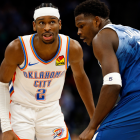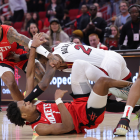
The 2019-20 Lakers were slow in everything but pace. They scored the second-most fast-break points in basketball, but when forced to generate offense in a half-court setting, their system ground to a halt. Virtually every metric pegged last season's champion as offensively stagnant. They were below average in both total passes and total touches. Their players had the third-lowest average movement speed on offense, and moved less in total than any team besides the James Harden-led Rockets, according to NBA.com tracking data. Unsurprisingly, they were 17th in half-court points per play as a result.
So far this season? The Lakers are in first. By a mile. It's a preposterously unsustainable sample, but if their 111.1 points per play did last, it would be the greatest half-court offense Cleaning the Glass has ever tracked (dating back to the 2003-04 season). It wouldn't be close either. Even the best version of the Stephen Curry-Kevin Durant Warriors never reached 102.
You could attribute the turnaround to any number of reasonable factors. Their roster appears substantially deeper, more talented and more versatile. They've been the beneficiaries of some early-season shooting luck, and they've played against two bad defenses. Both factors will level off. But there's been a more reliable development that won't, and it only just materialized in the Lakers' 127-91 demolition of the Minnesota Timberwolves. Marc Gasol is curing their stagnancy, and he's doing it in the simplest way imaginable: He's passing players the ball back.
Behold, the simplest majesty of the give-and-go. Dennis Schroder walks the ball up the court. He passes it back out to Marc Gasol. He sprints to the basket. Gasol makes sure the ball is there waiting for him when he gets there:
Seems easy enough, right? Gasol and LeBron James nabbed two quick points just as easily:
Again, basic stuff. Nobody's breaking any molds here. But such simple, eager ball movement is what the Lakers lacked last season, and it's not surprising given their personnel. LeBron led the NBA in assists last season, but in the seven seasons that have been tracked, his teams have finished 22nd on average in total passes per game. It's a different form of elite passing, one better suited to the drudgery of crunch time and the postseason. LeBron's drive-and-kick game is meant to capitalize on his gravity as a scorer and remarkable ability to read defenses. He passes directly into shots that he creates.
Gasol's passing comes with less direct intent. He's moving the ball for the sake of moving the ball, trusting that it will end in any good shot rather than a specific one. It's a more contagious form of ball movement, one that more encourages player movement by creating an atmosphere of recognition. If you buy into this ideology, you will be rewarded with shots.
That's how more complicated routes wind up leading to the same place. This play ends with Gasol and Kentavious Caldwell-Pope running a give-and-go, but it starts with another pass between the two:
Letting LeBron create is the easy way. It's usually going to work because, well, it's LeBron. The guy knows what he's doing. But as last year's Lakers found out, it can't be your only method of shot creation if you hope to have an elite offense. Gasol's path is the hard way. Sometimes it takes seven passes to create a shot. But taking the attitude that seven passes will create a shot creates a self-fulfilling prophecy. It reminds players to move and pass and react in ways that ultimately creates those shots. It engages reflexes that overreliance on a superstar can dull. Caldwell-Pope gets that ball on that play in a position in which he could have feasibly taken a bad shot. He kept the ball moving trusting that someone else would get a better one. It turns out, it was him, but even if it wasn't, it would've been on a later possession.
No Laker better embodied that philosophy on Sunday than Kyle Kuzma. Yes, he, too danced the give-and-go tango with Gasol:
But Gasol's first four assists on Sunday all went to Kuzma, and the selflessness rubbed off on him. He was quick to pass up a makeable look at the basket in the first quarter to get Gasol an open shot from the top of the arc:
He also took the scenic route, passing out of bad looks under that same assumption that doing so would lead to something better. Again, it brought him back to Gasol:
Kuzma's underlying potential as a passer has been evident since his rookie season, but it's not a particularly natural skill for him to indulge in given his shifting role over the past several years. Scoring was largely how he stayed on the floor early on. Even last year, as defense became more of a calling card for him, shots were a precious commodity on a team servicing two Hall of Famers. Asking that sort of player to make the sort of connective tissue passes that generate points but not assists is a tall order. Kuzma didn't always know when his next shot was coming. Passing them up posed risks.
But now? He's in on the fun, scoring style points instead of individual ones:
Rookie Kyle Kuzma with a head of steam was not passing up the chance to finish this drive. Veteran Kuzma mocks the clueless defenders who doubt his growth:
Gasol may be taking Kuzma on as his passing padawan, but the infectious effects of his team-first approach are being felt team-wide. A total of nine Lakers had at least two assists on Sunday. By contrast, three teams (the Celtics, Knicks and Pelicans) have all played three games already and don't have nine players on their roster with at least two assists this entire season. The Lakers improved upon every category from last season we mentioned above in their win over the Timberwolves.
| Lakers stats | 2019-20 | Sunday vs. Timberwolves |
|---|---|---|
Total passes | 283.9 | 299 |
Total touches | 407.4 | 423 |
Average offensive player speed (miles per hour) | 4.36 | 4.59 |
Total distance traveled on offense (miles) | 9.15 | 9.5 |
These aren't enormous leaps. They don't have to be. The Lakers have LeBron James and Anthony Davis. Sometimes it makes sense to just let your best players go to work.
But that was all the Lakers could do offensively last season, a flaw that Gasol is working to remedy. He doesn't have to turn the Lakers into the 2014 Spurs, and the Lakers don't need to have the greatest half-court offense of all time. He just has to keep his teammates engaged enough to do their jobs while James and Davis do theirs. He's found a very basic method of doing so: ensuring that his teammates know that when they give the ball up, they're going to get it back.









